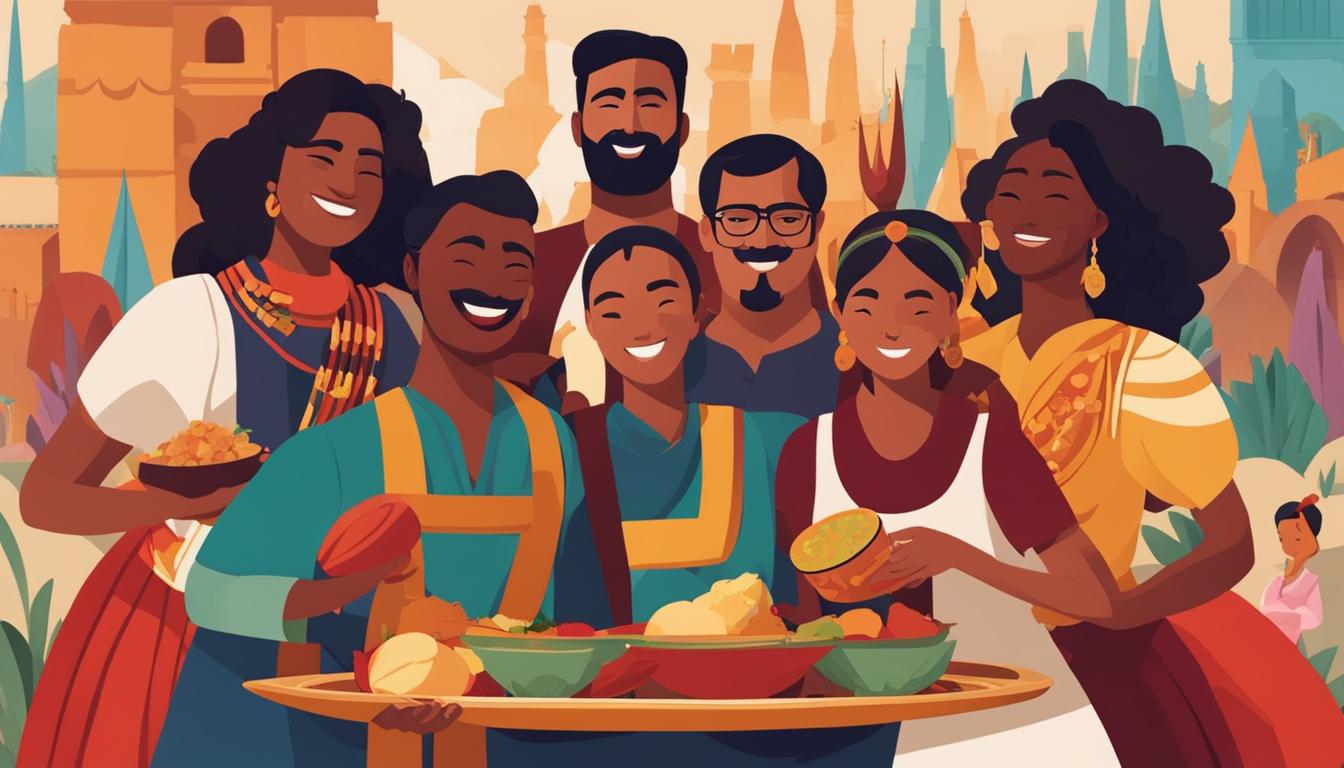Cultural adaptation is a crucial skill for individuals looking to thrive in a global environment. It involves navigating a new culture, adjusting to a different environment, and overcoming culture shock. By following effective cultural adaptation tips and strategies, individuals can foster successful cross-cultural connections and achieve global success. This article will provide valuable insights and techniques to master cultural adaptation and ensure a smooth transition into a new cultural setting.
Key Takeaways:
- Understand the importance of cultural adaptation for global success.
- Implement strategies such as researching the target culture and learning the language.
- Embrace local customs and develop empathy towards the host culture.
- Build a support network and adapt your communication style to align with cultural norms.
- Coping with culture shock is a crucial part of the adaptation process.
The Importance of Cultural Adaptation
Cultural adaptation is a critical factor in achieving success in today’s cross-cultural environments. It enables individuals to effectively communicate, understand, and connect with people from diverse cultures, fostering collaboration and mutual respect. By developing cultural intelligence and competence, individuals can navigate the complexities of a new cultural setting and build meaningful relationships with colleagues, clients, and stakeholders.
Cultural adaptation plays a pivotal role in ensuring global success, as it allows individuals to adapt their communication style, behavior, and mindset to align with cultural norms and expectations. It is through cultural adaptation that individuals can overcome barriers and build trust, enabling them to thrive in an increasingly globalized world.
Global success is not solely determined by technical skills or academic qualifications, but also by one’s ability to navigate and adapt to different cultural contexts. Cultural intelligence, which refers to an individual’s capability to understand and navigate cultural differences, is a key component of success in an interconnected world.
Moreover, cultural competence is the ability to interact effectively with people from different cultures, demonstrating respect, empathy, and openness. It involves developing an awareness of cultural nuances, values, and norms, which allows individuals to build bridges and establish connections that transcend cultural boundaries.
“Cultural adaptation is not just about fitting in; it’s about embracing diversity, connecting with others, and leveraging the richness of different perspectives.”
Through cultural adaptation, individuals can unlock opportunities for personal and professional growth. It opens doors to new experiences, expands horizons, and cultivates a broader worldview. By embracing cultural diversity and developing cultural intelligence, individuals can not only achieve success in their endeavors but also foster inclusivity and bridge cultural divides.
As we delve deeper into this article, we will explore strategies for effective cultural adaptation, coping with culture shock, real-world examples of successful cultural adaptation by global companies, and tips for a smooth relocation and adaptation process. By understanding the importance of cultural adaptation and applying the appropriate techniques, individuals can navigate new cultural environments with confidence, achieving global success while embracing the richness of cultural diversity.
Strategies for Cultural Adaptation
To successfully navigate a new culture and adapt to a different environment, it is essential to employ specific strategies. These strategies will enhance your cultural adaptation journey, making it a smoother and more enriching experience.
1. Research the target culture: Gain a comprehensive understanding of the customs, traditions, values, and social norms of the culture you are entering. This knowledge will provide invaluable insights and help you avoid potential cultural misunderstandings.
2. Learn the language: Language is a powerful tool for connecting with others and immersing oneself in a new culture. Make an effort to learn the local language as it will open doors to meaningful interactions and demonstrate respect for the host culture.
3. Embrace local customs: Immerse yourself in the local customs and traditions. Participate in cultural events, celebrations, and rituals. By actively engaging with the cultural practices, you demonstrate a willingness to embrace and respect the local way of life.
4. Develop empathy: Cultivate empathy towards the host culture by seeking to understand their perspectives, beliefs, and values. This will allow you to build genuine connections and foster positive relationships with locals.
5. Build a support network: Surround yourself with individuals who have experience in the target culture, such as locals and expats. They can provide guidance, support, and a sense of belonging, making the adaptation process more comfortable and enjoyable.
6. Be open-minded: Approach your cultural adaptation journey with an open mind. Embrace new experiences and be willing to challenge preconceived notions and stereotypes. This mindset will enable you to embrace the diversity of the culture and navigate potential cultural differences with ease.
7. Adapt your communication style: Communication styles vary across cultures. Pay attention to cultural cues and adapt your communication style accordingly. This includes verbal and non-verbal communication, such as body language and tone of voice.
Quote:
“Cultural adaptation is not about losing your identity, but about expanding your horizons and embracing the beauty of diversity.”
By implementing these strategies, you will be well-equipped to navigate the challenges of cultural adaptation and thrive in your new cultural environment.
Coping with Culture Shock
Culture shock is a natural part of adapting to a new culture. It involves a series of stages that individuals typically go through during their transition. These stages include the honeymoon phase, negotiation phase, and adjustment phase.
In the honeymoon phase, individuals are often filled with excitement and fascination about the new culture. Everything seems novel and interesting. However, as the novelty wears off, the negotiation phase begins. This is where individuals may start to experience homesickness and frustration due to language barriers and cultural differences.
During the adjustment phase, individuals gradually adapt and become more comfortable in their new cultural environment. They start to understand the local customs and practices and navigate daily life with ease. However, it’s important to note that everyone experiences culture shock differently, and the duration of each phase can vary.
Homesickness is a common emotion experienced during culture shock. It’s natural to miss the familiarity of one’s home country, family, and friends. To cope with homesickness, staying connected with loved ones through video calls, emails, or letters can provide emotional support.
Overcoming stereotypes is another crucial aspect of coping with culture shock. It’s essential to approach the new culture with an open mind and challenge any preconceived notions. Engaging in conversations with locals, embracing their perspectives, and actively learning about their customs and traditions can help break down stereotypes and foster cultural understanding.
“Culture shock is the uncomfortable feeling of uncertainty that arises when immersed in an unfamiliar culture. It’s a powerful opportunity for growth and self-discovery.”
Maintaining a positive attitude is also key to coping with culture shock. Embracing the challenges as opportunities for personal and cultural growth can help individuals overcome the initial discomfort and make the most of their experience in a new country.

Real-World Examples of Successful Cultural Adaptation
Many global companies have understood the significance of cultural adaptation in business. By effectively incorporating localization strategies into their operations, these companies have achieved success in the global marketplace. Let’s explore some notable examples:
1. McDonald’s Localization of Menus
McDonald’s, a renowned fast-food chain, has successfully implemented cultural adaptation by tailoring their menus to cater to local tastes. By offering region-specific menu items and incorporating local ingredients and flavors, McDonald’s attracts customers and ensures their offerings align with the preferences of different cultures.
2. Coca-Cola’s Multilingual Global Campaigns
Coca-Cola, a global beverage brand, has excelled in cultural adaptation through its multilingual campaigns that transcend linguistic barriers. By creating advertisements and marketing materials in multiple languages, Coca-Cola effectively communicates with diverse audiences and instills a sense of connection and inclusivity.
3. IKEA’s Regional Adjustments to Catalogs
IKEA, a leading furniture retailer, has implemented cultural adaptation strategies in its catalogs. By showcasing furniture arrangements and designs that reflect the unique preferences and lifestyles of different regions, IKEA ensures that its products resonate with local customers and meets their specific needs.
These real-world examples highlight the importance of understanding and adapting to local cultures. By tailoring their offerings, marketing campaigns, and product presentations, companies can successfully establish themselves in foreign markets and foster strong relationships with their target audiences.
| Company | Adaptation Approach |
|---|---|
| McDonald’s | Localization of menus to cater to local tastes |
| Coca-Cola | Multilingual global campaigns transcending linguistic barriers |
| IKEA | Regional adjustments to catalogs reflecting local preferences |
Tips for a Smooth Relocation and Adaptation Process
Relocating to a new country can be an exciting yet challenging experience. To ease the transition and ensure a smooth adaptation process, there are several key tips to keep in mind.
- Research the New Country: Before moving, take the time to thoroughly research your destination. Learn about its culture, traditions, customs, and local laws. Familiarize yourself with the local cuisine, social norms, and important landmarks. This knowledge will help you adapt faster and navigate your new surroundings with confidence.
- Learn the Language: One of the most important aspects of cultural adaptation is learning the language spoken in your new country. Take language courses, practice regularly, and immerse yourself in the local language as much as possible. Being able to communicate effectively will greatly enhance your experience and help you build meaningful connections.
- Build a Support System: Moving to a new country can feel isolating, so it’s essential to build a support system. Reach out to expat communities, join local clubs or organizations, and make an effort to meet new people. Having a support network will provide guidance, friendship, and a sense of belonging, making your transition easier.
- Stay Connected with Loved Ones: Moving abroad doesn’t mean losing touch with your loved ones. Stay connected with family and friends through regular calls, video chats, and messages. Share your experiences and seek support when needed. Their encouragement and presence, even from a distance, will help you feel connected and grounded.
- Explore New Surroundings: Embrace the opportunity to discover your new surroundings. Take the time to explore the local attractions, landmarks, and hidden gems. Immerse yourself in the culture by trying local cuisine, attending festivals, and participating in community events. This sense of exploration will enrich your experience and foster a deeper connection with your new home.
- Be Patient: Cultural adaptation takes time, so be patient with yourself throughout the process. Understand that adjusting to a new country can be challenging, and there may be moments of frustration or homesickness. Stay positive, embrace the learning curve, and celebrate small victories along the way.
By following these tips, you can navigate the relocation and adaptation process with confidence and ease. Remember, cultural adaptation is a journey of personal growth and discovery, providing you with invaluable experiences and lifelong memories.
Cultural Adaptation Tips Recap
Cultural adaptation is a crucial skill for individuals seeking global success and forming cross-cultural connections. By implementing the cultural adaptation tips and strategies discussed in this article, individuals can confidently navigate new cultural environments. Conducting research on the target culture and learning the language are essential steps in the cultural learning process. Embracing local customs and building a support network of both locals and expats can significantly aid in cultural integration.
Cultural adaptation is an ongoing journey of personal and professional growth. By being open-minded and flexible, individuals can adapt their communication styles to align with cultural norms and overcome potential challenges. Through cultural integration, individuals can not only achieve success in the global marketplace but also foster meaningful cross-cultural connections.
Mastering cultural adaptation empowers individuals to embrace diversity and gain a deeper understanding of different cultures. It enriches personal perspectives, broadens horizons, and facilitates effective cross-cultural communication. By investing in cultural learning strategies and continuously honing cultural adaptation skills, individuals can unlock their full potential in an increasingly interconnected world.
Learn More About the Life of a Travel Nurse
What is cultural adaptation?
Cultural adaptation is the process of navigating and adjusting to a new culture and environment. It involves acquiring cultural intelligence, developing empathy, and learning to communicate effectively with people from different cultural backgrounds.
Why is cultural adaptation important?
Cultural adaptation is important for achieving success in cross-cultural environments. It enables effective communication, understanding, and connection with people from different cultures, fostering collaboration, mutual respect, and personal and professional growth.
What are some strategies for cultural adaptation?
Strategies for cultural adaptation include conducting research on the target culture, learning the language, embracing local customs, developing empathy, building a support network, being open-minded, and adapting communication styles to align with cultural norms.
How can I cope with culture shock?
Coping with culture shock involves recognizing the stages of culture shock, overcoming stereotypes, maintaining a positive attitude, and seeking support from others experiencing a similar transition.
Can you provide examples of successful cultural adaptation in business?
Yes, examples include McDonald’s localization of their menus, Coca-Cola’s multilingual campaigns, and IKEA’s regional adjustments to their catalogs. These examples show how understanding and adapting to local cultures can lead to success in the global marketplace.
What tips can you provide for a smooth relocation and adaptation process?
Tips for a smooth relocation and adaptation process include researching the new country, learning the language, building a support system, staying connected with loved ones, exploring new surroundings, and practicing patience.
How does cultural adaptation contribute to global success?
Cultural adaptation is a fundamental skill for achieving global success. By mastering cultural adaptation and cross-cultural connections, individuals can navigate new cultural environments with confidence, competence, and enhanced personal and professional growth.




